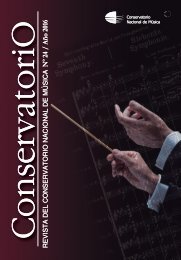Prospecto de Admision 2018
You also want an ePaper? Increase the reach of your titles
YUMPU automatically turns print PDFs into web optimized ePapers that Google loves.
46 • Interpretar tres obras, una <strong>de</strong> cada<br />
numeral:<br />
Sección <strong>de</strong> Estudios Preparatorios - Programa Escolar<br />
1. J. S. Bach: “Libro <strong>de</strong> Ana Magdalena<br />
Bach”, “Pequeños Preludios” u otra<br />
obra <strong>de</strong> dificultad equivalente <strong>de</strong>l<br />
mismo periodo.<br />
2. Sonatina clásica completa.<br />
3. R. Schumann: “Álbum para la<br />
Juventud”; E. Grieg: “Piezas Líricas”;<br />
D. Kabalevsky: “Pequeñas Piezas”;<br />
A. Khatchaturian: “Las aventuras <strong>de</strong><br />
Iván”; B. Bartók: “Para niños” u otras<br />
similares <strong>de</strong> compositores románticos,<br />
mo<strong>de</strong>rnos o contemporáneos.<br />
A partir <strong>de</strong> los 15 años<br />
• Tocar <strong>de</strong> memoria todas las escalas<br />
mayores y menores armónicas y<br />
melódicas, con sus respectivos arpegios<br />
e inversiones en tres octavas.<br />
• Interpretar un estudio <strong>de</strong> la “Escuela <strong>de</strong> la<br />
Velocidad” Op. 299. <strong>de</strong> C. Czerny u otro<br />
<strong>de</strong> dificultad equivalente.<br />
• Interpretar tres obras originales, una <strong>de</strong><br />
cada numeral:<br />
1. J. S. Bach: “Invenciones a dos voces”<br />
u otra <strong>de</strong> dificultad equivalente y <strong>de</strong>l<br />
mismo periodo.<br />
2. Primer movimiento <strong>de</strong> alguna sonata<br />
<strong>de</strong> J. Haydn, W. A. Mozart o L. v.<br />
Beethoven.<br />
3. Una obra <strong>de</strong> compositor romántico,<br />
mo<strong>de</strong>rno o contemporáneo:<br />
F. Chopin (Valses), F. Men<strong>de</strong>lssohn<br />
(Canciones sin palabras) u otra <strong>de</strong><br />
dificultad equivalente.<br />
SAXOFÓN<br />
De 9 a 11 años<br />
• Interpretar dos piezas <strong>de</strong> diferente<br />
carácter.<br />
De 12 a 14 años<br />
• Tocar <strong>de</strong> memoria dos escalas mayores y<br />
menores con sus arpegios.<br />
• Interpretar el Estudio N° 2 <strong>de</strong> “50 Étu<strong>de</strong>s<br />
Faciles & Progressives pour Saxophone”<br />
<strong>de</strong> G. Lacour (Ed. Gérard Billaudot<br />
Nouvelle édition, Paris 1989).<br />
• Interpretar un estudio o pieza <strong>de</strong> libre<br />
elección.<br />
A partir <strong>de</strong> los 15 años<br />
• Tocar <strong>de</strong> memoria tres escalas mayores<br />
y menores con sus arpegios, en dos<br />
octavas.<br />
• Interpretar los Estudios N°s 4, 9 y 12<br />
<strong>de</strong> “50 Étu<strong>de</strong>s Faciles & Progressives<br />
pour Saxophone” <strong>de</strong> G. Lacour (Ed.<br />
Gérard Billaudot, Nouvelle édition Paris<br />
1989).<br />
• Interpretar un estudio u obra <strong>de</strong> libre<br />
elección.<br />
TROMBÓN<br />
Se pue<strong>de</strong> presentar este examen con eufonio.<br />
De 9 a 11 años<br />
• Tocar las escalas y arpegios mayores <strong>de</strong><br />
Si bemol y Do en una octava en tiempo<br />
lento.<br />
• Interpretar el Estudio N° 1 <strong>de</strong> “40<br />
Progressive Etu<strong>de</strong>s for Trombone” <strong>de</strong> S.<br />
Hering.<br />
• Interpretar a libre elección una pequeña<br />
melodía <strong>de</strong> fácil ejecución.



